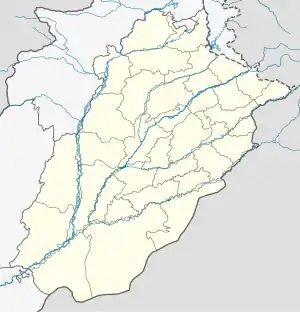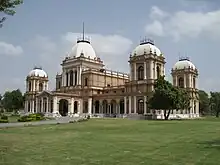| Noor Mahal | |
|---|---|
 Noor Mahal, Bahawalpur | |
 Location within Punjab, Pakistan  Noor Mahal (Pakistan) | |
| General information | |
| Architectural style | Italian chateau on neoclassical lines |
| Town or city | Bahawalpur |
| Country | |
| Coordinates | 29°22′45″N 71°40′04″E / 29.3792°N 71.6679°E |
| Construction started | 1872 |
| Completed | 1875 |
| Technical details | |
| Size | 44,600 square feet (4,140 m2) |
| Design and construction | |
| Architect(s) | Mr. Heennan |
The Noor Mahal (Urdu: نور محل) is a historic real estate owned by the Ministry of Defense (MoD) under the management of the Army Secretariat in Bahawalpur, Punjab, Pakistan.
It was built in 1872 as an Italian chateau on neoclassical lines, at a time when modernism had set in. It belonged to the Nawabs of Bahawalpur princely state, during the British Raj.[1]
History

There are various stories regarding its construction. According to the sources Nawab Sir Sadiq Abbasi built the Palace for himself.[2]
Noor Mehal is one of the hidden gems of Bahawalpur, due to the lack of publicity. The palace is open to public. It is currently in the possession of the Pakistan Army and is used as a state guest house for holding state durbars and meetings with foreign delegations. The Nawab was used to occasionally conduct cabinet sessions in Noor Mahal when he was in power.[3]
Architecture

Mr. Heennan, an Englishman who was the state engineer, designed the building. The foundation of Noor Palace was laid in 1872. A map and coins of the state were buried in its foundation as a good omen. Most of the palace's materials and furniture were imported from England and Italy. The construction of the palace was completed in 1875 at a cost of Rs. 1.2 million. Considering the amount of silver in the Indian Rupee Coin at 11.66 Grams in 1862, this amount in 2016 would come to about 8.1 million US dollars. Noor Palace covers an area of 44,600 square feet (4,140 m2). It has 32 rooms including 14 in the basement, 6 verandas and 5 domes.[4]
The design encompasses features of Corinthian and Islamic styles of architecture with a tinge of subcontinental style. The Corinthian touch is visible in the columns, balustrade, pediments and the vaulted ceiling of Durbar Hall. The Islamic style is evident in the five domes, whereas the angular elliptical shapes are a stroke of subcontinent style. Nawab Muhammad Bahawal Khan the fifth added a mosque to the palace in 1906 at the cost of Rs. 20,000. The design is based on the mosque of Aitchison College.
In 1956, when Bahawalpur State was merged into Pakistan, the building was taken over by the Auqaf department. The palace was leased to the army in 1971; in 1997 the army purchased it for the sum of 119 million.
The building was declared a “protected monument” in September 2001 by the Government of Pakistan's Department of Archeology, and it is now open for general visitors, students trips and other interested persons.
Things to see
There are a lot of artefacts in the palace. It includes many objects used by the Nawabs - swords, currency notes and coins, legal documents, furniture, and a piano. There is also a long wall in it that contains photos of Nawabs. Only one picture is real, all others are imaginary. There is also a prison cell aside the palace.
Gallery
 A night view of the Noor Mahal
A night view of the Noor Mahal Side view of the Noor Mahal
Side view of the Noor Mahal
 Noor Mahal front view day time
Noor Mahal front view day time Noor Mahal After Rain
Noor Mahal After Rain A beautiful dining room at Noor Mahal for visitors
A beautiful dining room at Noor Mahal for visitors Noor Mahal decorative tile floors
Noor Mahal decorative tile floors Display of historical knives at wall of Noor Mahal
Display of historical knives at wall of Noor Mahal A beautiful Balcony at Noor Mahal
A beautiful Balcony at Noor Mahal
See also
References
- ↑ The Bahawalpur.com - Noor Mahal
- ↑ History of Noor Mahal Bahawalpur - daaira.com
- ↑ "Noor Mahal - A Majestic Heritage". Today 24 News. 2 April 2023. Retrieved 26 April 2023.
- ↑ Noor Mahal - History
External links
29°22′46″N 71°40′05″E / 29.37944°N 71.66806°E

